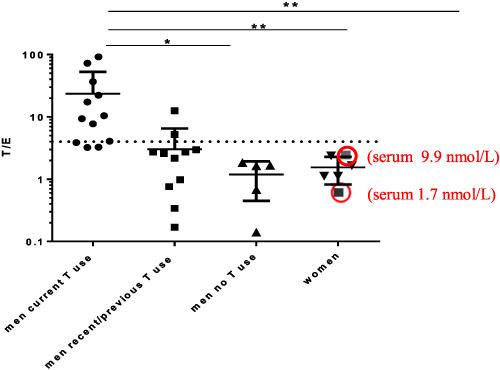当前位置:
X-MOL 学术
›
Drug Test. Anal.
›
论文详情
Our official English website, www.x-mol.net, welcomes your
feedback! (Note: you will need to create a separate account there.)
Studies of athlete biological passport biomarkers and clinical parameters in male and female users of anabolic androgenic steroids and other doping agents.
Drug Testing and Analysis ( IF 2.6 ) Pub Date : 2020-01-29 , DOI: 10.1002/dta.2763 Annica Börjesson 1, 2 , Mikael Lehtihet 3 , Alexander Andersson 2, 4 , Marja-Liisa Dahl 1, 2 , Veronica Vicente 5, 6 , Magnus Ericsson 1, 2, 4 , Lena Ekström 1
Drug Testing and Analysis ( IF 2.6 ) Pub Date : 2020-01-29 , DOI: 10.1002/dta.2763 Annica Börjesson 1, 2 , Mikael Lehtihet 3 , Alexander Andersson 2, 4 , Marja-Liisa Dahl 1, 2 , Veronica Vicente 5, 6 , Magnus Ericsson 1, 2, 4 , Lena Ekström 1
Affiliation

|
The use of anabolic androgenic steroids (AAS) and other performance enhancing substances can change over time, so there is a need to constantly update what substances are used and can be detected. Six women and 30 men anabolic androgenic steroid users were recruited who filled out an anonymous questionnaire about their use of performance enhancing substances during the past year. Sampling took place on a single occasion and included blood and urine collection. Our aim was to identify which doping agents can be detected in men and women self‐reporting AAS use. The first choice of substances differed between men (testosterone) and women (oxandrolone). The use of growth hormones was reported among men (10%) and women (50%). Growth hormone releasing factors/secretagogs were reported by about ~ 20% in both genders. Nandrolone was the most frequently detected anabolic androgenic steroid even in those who did not report use in the past year. Of the current male testosterone users, 82% exhibited testosterone/epitestosterone (T/E) ratios of > 4. Men with current testosterone use displayed 4‐fold and 6‐fold higher median T/E, respectively, when compared with recent and previous testosterone users (P = 0.0001). Dermal testosterone use in women (n = 2) was not associated with a T/E ratio of > 4, but with supra‐physiological total serum testosterone concentrations. Changes in gonadotropins and hematological parameters were associated with the time of the last anabolic androgenic steroid intake in men, whereas in women these biomarkers were within the normal range. This highlights gender specific differences and indicates the need for additional biomarkers in female athletes.
中文翻译:

对合成代谢雄激素类固醇和其他掺杂剂男女的运动员生物护照生物标志物和临床参数的研究。
合成代谢雄激素类固醇(AAS)和其他增强性能的物质的使用会随着时间而变化,因此需要不断更新使用和检测到的物质。招募了6名女性和30名男性合成代谢类固醇激素使用者,他们填写了有关他们在过去一年中使用性能增强物质的匿名调查表。采样只进行一次,包括血液和尿液的采集。我们的目标是确定在自我报告AAS的男性和女性中可以检测到哪些掺杂剂。男性(睾丸激素)和女性(氧雄龙)的首选物质不同。据报道,男性(10%)和女性(50%)使用了生长激素。据报道,两种性别的生长激素释放因子/分泌激素均约占20%。Nandrolone是最常见的合成代谢雄激素类固醇,即使在过去一年没有报告使用的人中也是如此。在目前的男性睾丸激素使用者中,有82%的男性睾丸激素/睾丸激素(T / E)比率>4。与最近和以前相比,当前使用睾丸激素的男性的中位T / E分别高4倍和6倍。睾丸激素使用者(P = 0.0001)。妇女使用皮肤睾丸激素(n = 2)与T / E比率> 4无关,但与超生理学血清总睾丸激素浓度相关。男性促性腺激素和血液学参数的变化与上一次合成代谢雄激素类固醇摄入的时间有关,而女性中这些生物标记物在正常范围内。这突出了性别差异,并表明在女运动员中需要其他生物标志物。
更新日期:2020-01-29
中文翻译:

对合成代谢雄激素类固醇和其他掺杂剂男女的运动员生物护照生物标志物和临床参数的研究。
合成代谢雄激素类固醇(AAS)和其他增强性能的物质的使用会随着时间而变化,因此需要不断更新使用和检测到的物质。招募了6名女性和30名男性合成代谢类固醇激素使用者,他们填写了有关他们在过去一年中使用性能增强物质的匿名调查表。采样只进行一次,包括血液和尿液的采集。我们的目标是确定在自我报告AAS的男性和女性中可以检测到哪些掺杂剂。男性(睾丸激素)和女性(氧雄龙)的首选物质不同。据报道,男性(10%)和女性(50%)使用了生长激素。据报道,两种性别的生长激素释放因子/分泌激素均约占20%。Nandrolone是最常见的合成代谢雄激素类固醇,即使在过去一年没有报告使用的人中也是如此。在目前的男性睾丸激素使用者中,有82%的男性睾丸激素/睾丸激素(T / E)比率>4。与最近和以前相比,当前使用睾丸激素的男性的中位T / E分别高4倍和6倍。睾丸激素使用者(P = 0.0001)。妇女使用皮肤睾丸激素(n = 2)与T / E比率> 4无关,但与超生理学血清总睾丸激素浓度相关。男性促性腺激素和血液学参数的变化与上一次合成代谢雄激素类固醇摄入的时间有关,而女性中这些生物标记物在正常范围内。这突出了性别差异,并表明在女运动员中需要其他生物标志物。











































 京公网安备 11010802027423号
京公网安备 11010802027423号